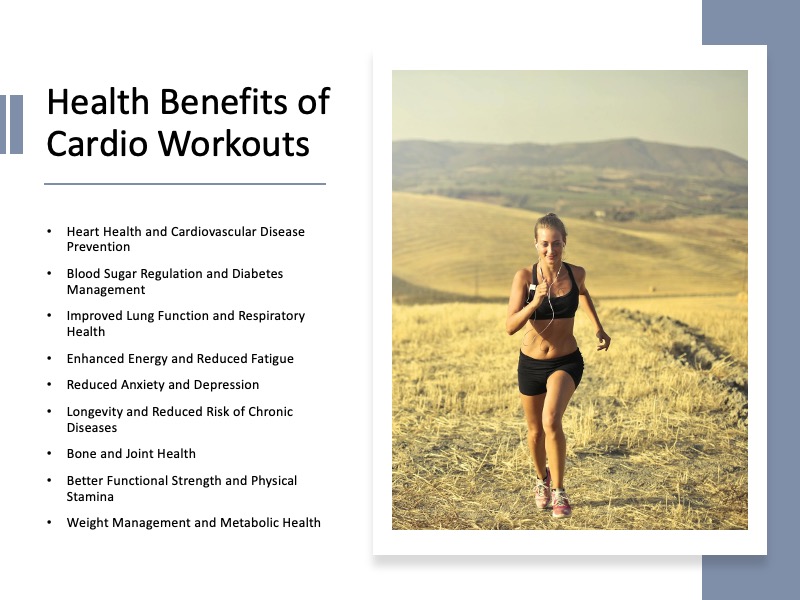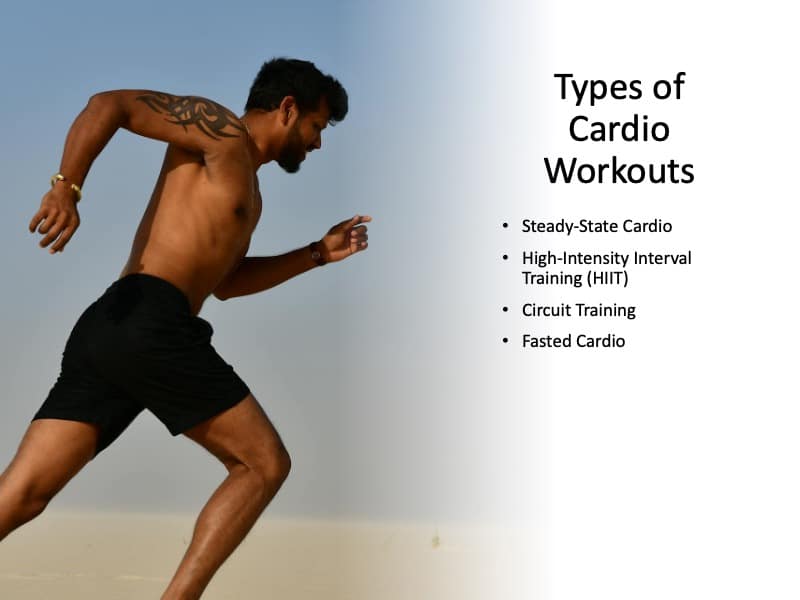Cardio Workouts 101: The Complete Guide to Cardio Training
Cardio workouts are essential for weight loss, cardiovascular health, and overall fitness. By elevating the heart rate and burning calories, cardiovascular exercises contribute to a healthy body composition, improved endurance, and mental well-being.
However, cardio doesn’t have to be a monotonous or singular routine.
From brisk walking to high-intensity interval training (HIIT) and fun activities like agility drills, there are numerous ways to incorporate effective cardio workouts that align with personal fitness goals.
This guide covers everything you need to know about cardio exercises, including their benefits, types, safety tips, optimal frequency, and the best exercises for weight loss.
What is Cardiovascular Exercise?
Cardiovascular exercise, often referred to as “cardio,” involves any physical activity that raises your heart rate and promotes blood circulation. It primarily requires the body to use oxygen to produce energy, resulting in calorie burning and improved heart health.
For those looking to lose weight, cardio exercises increase calorie expenditure, helping to create a calorie deficit essential for weight loss.
Furthermore, cardio workouts are beneficial for strengthening the heart, enhancing lung capacity, and boosting mood due to the release of endorphins, or “feel-good” hormones.
Health Benefits of Cardio Workouts

Cardiovascular exercise, commonly known as cardio, is widely recognized for its ability to promote weight loss, but its benefits extend well beyond the scale.
Engaging in regular cardio workouts is fundamental to maintaining overall health and wellness.
From enhancing heart health to improving mental well-being, cardio workouts provide a holistic approach to fitness that supports both the mind and body.
1.) Heart Health and Cardiovascular Disease Prevention
One of the most significant benefits of cardio is its positive impact on heart health. Cardio exercises help strengthen the heart muscle, allowing it to pump blood more efficiently throughout the body.
This improvement in circulation reduces the risk of high blood pressure and lowers LDL (bad) cholesterol levels, which are often linked to heart disease (American Heart Association, 2019).
Regular cardio workouts have been shown to reduce the risk of coronary heart disease, stroke, and heart attack, making it a crucial component in heart disease prevention.
2.) Blood Sugar Regulation and Diabetes Management
Cardio exercise plays an important role in regulating blood sugar levels, making it especially beneficial for individuals with type 2 diabetes or those at risk. Physical activity increases insulin sensitivity, allowing the body to use glucose more effectively for energy.
This effect helps stabilize blood sugar levels, making cardio essential for managing diabetes and preventing blood sugar spikes (American Diabetes Association).
3.) Improved Lung Function and Respiratory Health
Regular cardio workouts can significantly improve lung capacity and overall respiratory health.
By training the lungs to work more efficiently, cardio enhances oxygen exchange and strengthens the respiratory muscles.
Activities like running, swimming, and cycling force the lungs to work harder to supply oxygen, ultimately boosting lung function and reducing shortness of breath during daily activities.
4.) Increased Energy and Reduced Fatigue
Cardio workouts improve the efficiency of the cardiovascular and respiratory systems, leading to higher energy levels and reduced feelings of fatigue.
Consistent cardio exercise enhances circulation, ensuring that muscles and organs receive adequate oxygen and nutrients, which promotes sustained energy levels throughout the day.
A study published in Psychotherapy and Psychosomatics found that regular exercise, including cardio, reduces symptoms of chronic fatigue and enhances overall energy and vitality.
5.) Reduced Anxiety and Depression
Cardio workouts have profound benefits for mental health, reducing symptoms of anxiety, depression, and stress.
Physical activity stimulates the release of endorphins, dopamine, and serotonin, which are mood-enhancing chemicals in the brain (Harvard Health Publishing, 2018).
Cardio exercise also encourages mindfulness and focus, providing a natural outlet for managing stress. Regular cardio can act as a powerful mental health tool, helping reduce the risk of mood disorders and promoting a positive outlook.
6.) Longevity and Reduced Risk of Chronic Diseases
Engaging in regular cardio exercise contributes to longevity by reducing the risk of chronic illnesses such as heart disease, diabetes, and certain cancers. Cardio workouts lower inflammation in the body and improve immune function, enhancing resilience against disease.
A study in the Journal of the American Medical Association revealed that consistent physical activity, including cardio, is associated with increased life expectancy and a lower risk of premature death (Lee et al., 2011).
7.) Bone and Joint Health
Low-impact cardio exercises, such as walking and swimming, can improve bone density and joint health, reducing the risk of osteoporosis and arthritis-related pain.
Weight-bearing cardio exercises, like running or brisk walking, promote bone remodeling, which is essential for bone strength and density.
Additionally, regular cardio helps improve joint flexibility and mobility, making it easier to perform daily tasks and maintain an active lifestyle, especially as we age.
8.) Better Functional Strength and Physical Stamina
Cardio exercise helps build functional strength and physical stamina, enabling individuals to perform everyday activities with ease.
Exercises like cycling, running, and rowing enhance muscle endurance and strengthen the core, back, and legs, which are essential for physical tasks such as lifting, bending, and carrying.
‘Improved physical stamina also supports recreational activities and sports, enhancing overall quality of life.
9.) Weight Management and Metabolic Health
Although it is a common fitness myth that cardio is the only way to burn fat, cardio workouts for weight loss are an effective way to increase calorie expenditure, which is essential for weight management and metabolic health.
By engaging in regular cardio, individuals can achieve and maintain a healthy weight, which lowers the risk of metabolic syndrome and related conditions.
Furthermore, cardio exercise helps regulate metabolism by increasing the rate of calorie burning, both during and after workouts, which is beneficial for maintaining a healthy body composition and supporting long-term weight management goals.
Types of Cardio Workouts

Cardio workouts come in several forms and intensities, ranging from low-intensity walking to high-intensity interval training. Each type of cardio offers unique benefits and can be customized to fit personal fitness goals.
Incorporating a mix of aerobic and anaerobic exercises can optimize results and prevent monotony in your routine.
Steady-State Cardio
- Introduction: Steady-state cardio involves maintaining a consistent pace over an extended period. Examples include jogging, swimming, and cycling. This type of cardio is ideal for beginners or those looking to improve endurance and cardiovascular health gradually.
- Benefits: Enhances cardiovascular endurance, improves mental focus, and can be performed at various intensity levels.
High-Intensity Interval Training (HIIT)
- Explanation: High-intensity interval Training (HIIT) alternates between intense bursts of activity and short rest periods, providing a time-efficient workout that continues burning calories after exercise due to the afterburn effect.
- Benefits: The primary benefits of HIIT include increased calorie burning, improved cardiovascular fitness, and promoted metabolic benefits that support long-term weight loss.
Circuit Training
- Explanation: Combining cardio and strength exercises in a continuous loop, circuit training keeps the heart rate elevated while engaging various muscle groups.
- Benefits: Increases calorie burn, builds strength, and enhances muscle endurance.
Fasted Cardio
- Explanation: Fasted cardio is performed on an empty stomach, usually in the morning, and is thought to promote fat oxidation by relying on stored body fat for energy.
- Benefits: Potentially increases fat-burning efficiency, especially at low to moderate intensities.
Aerobic vs. Anaerobic Cardiovascular Endurance: What is the Difference

Cardiovascular endurance is the ability of the heart, lungs, and blood vessels to deliver oxygen efficiently to muscles during prolonged physical activity.
This endurance can be categorized into two main types: aerobic and anaerobic.
Each type uses different energy systems and supports distinct aspects of physical performance, so incorporating both aerobic and anaerobic exercises is essential for a well-rounded fitness regimen.
What is Aerobic Endurance?
Aerobic endurance refers to the body’s ability to sustain prolonged exercise that relies on oxygen to fuel energy production. This type of endurance is developed through low to moderate-intensity exercises performed over an extended period.
Activities like jogging, swimming, and cycling are primarily aerobic because they keep the heart rate elevated without overloading the muscles with short bursts of power.
During aerobic exercise, the body primarily uses fat and carbohydrates as energy sources, burning them slowly with the help of oxygen.
As exercise duration continues, the body gradually becomes more efficient at delivering oxygen to the muscles, which improves overall stamina and allows for longer, continuous activity.
- Benefits of Aerobic Endurance: Improved heart and lung efficiency, reduced risk of chronic diseases, enhanced metabolism, and the ability to sustain daily physical activities with less fatigue.
What is Anaerobic Endurance?
Anaerobic endurance involves the body’s capacity to perform high-intensity, short-duration activities where oxygen intake isn’t sufficient to meet energy demands. In these situations, the body relies on stored energy sources, specifically glycogen, to generate quick bursts of power.
Anaerobic exercises include sprinting, weightlifting, high-intensity interval training (HIIT), and explosive movements that elevate the heart rate to near maximum in short intervals.
Since oxygen is not used to fuel anaerobic exercise, the body’s primary energy source is glycogen, a stored form of carbohydrate in muscles and the liver. This energy system only sustains activity for a limited time—generally up to two minutes.
Anaerobic training is particularly beneficial for building strength, speed, and power.
- Benefits of Anaerobic Endurance: Increased muscle strength, improved ability to perform high-intensity tasks, enhanced metabolism due to the afterburn effect, and greater development of fast-twitch muscle fibers.
Reasons You Should Do Both Anaerobic and Aerobic Cardio Workouts
A balanced exercise routine should include both aerobic and anaerobic training to develop comprehensive cardiovascular and muscular endurance.
Each type of endurance benefits specific physical capabilities and supports different fitness goals:
- Balanced Cardiovascular Health: Aerobic exercise strengthens the heart and lungs, making daily activities less tiring, while anaerobic exercise builds power and increases the heart’s capacity to handle intense bouts of activity. Together, they support cardiovascular health and resilience.
- Increased Calorie Burning and Weight Loss: Aerobic exercises burn calories steadily during activity, while anaerobic exercises contribute to an “afterburn effect” (excess post-exercise oxygen consumption, or EPOC), allowing the body to burn calories even after the workout. The combination maximizes calorie burn and supports weight management goals.
- Enhanced Muscular Endurance and Strength: Aerobic activities build endurance in slow-twitch muscle fibers, ideal for activities requiring stamina, while anaerobic exercises strengthen fast-twitch fibers for short bursts of power. Both are essential for improving overall muscular health and physical capability.
- Metabolic Flexibility: The body becomes more metabolically adaptable when trained in both aerobic and anaerobic endurance. This flexibility helps the body transition between energy sources (fat, carbohydrates, glycogen) more effectively, optimizing performance in a wide range of activities.
- Mental Resilience and Focus: Aerobic exercise promotes relaxation and mental clarity, while anaerobic exercise trains the body to handle discomfort and push through high-intensity demands. This dual approach builds physical and mental endurance, enhancing overall resilience.
How to Develop Aerobic and Anaerobic Endurance
A well-rounded fitness plan should include both aerobic and anaerobic exercises, with each type appropriately distributed based on individual fitness goals and current fitness level.
- For Aerobic Endurance: Engage in 30-60 minutes of moderate-intensity cardio exercises, like jogging, swimming, or brisk walking, several times per week. Increasing the duration and variety of activities can improve aerobic capacity.
- For Anaerobic Endurance: Incorporate high-intensity activities like sprints, HIIT, or strength training 2-3 times per week. These workouts typically last 20-30 minutes and include short bursts of high-intensity activity followed by brief rest periods.
By combining aerobic and anaerobic endurance training, individuals can develop a versatile and resilient cardiovascular system, support optimal body composition, and improve their capacity to handle various physical demands, from sustained endurance to powerful, quick movements.
How to Incorporate Cardio into Your Routine
To make cardio safe and effective, consider gradually increasing workout intensity and duration. Beginners should start with low-impact activities, such as walking or cycling, before advancing to more intense forms of cardio.
Additionally, properly warming up before your workouts and cooling down after cardio workouts can prevent injury and improve recovery.
Frequency and Duration of Cardio Workouts
The American Heart Association recommends at least 150 minutes of moderate-intensity or 75 minutes of high-intensity cardio per week for adults.
For those focused on weight loss, increasing cardio to 200-300 minutes per week may yield additional benefits.
However, balancing cardio with strength training and rest days is essential for sustainable progress.
Ways to Make Cardio Fun and Engaging
Cardio doesn’t have to be dull. Adding variety, such as dancing, group classes, outdoor runs, or using different cardio equipment, can make workouts more enjoyable. Participating in sports, martial arts, or interval-based workouts like Tabata can also add a fun challenge, keeping motivation high and workouts consistent.
Best Cardio Exercises
Certain cardio exercises are particularly effective because they involve multiple muscle groups and high-intensity intervals. Here are some of the top cardio workouts for shedding pounds:
- Walking: A beginner-friendly, low-impact exercise that promotes fat burning.
- Running or Jogging: High-calorie burn, accessible, and improves cardiovascular endurance.
- Stair Climbing: Targets lower body muscles while burning calories efficiently.
- Jumping Rope: Engages the full body, improves coordination, and elevates heart rate.
- Rowing Machine: Provides a low-impact, full-body workout ideal for calorie burning and endurance.
- Swimming: A low-impact, full-body exercise that is gentle on the joints.
- Cycling: Great for both indoor stationary biking and outdoor workouts, cycling is low-impact yet effective for calorie burning.
- Martial Arts: Combines strength, coordination, and cardio for a fun and intense workout.
- Agility Ladder Drills: High-intensity cardio that improves agility, balance, and coordination.
- Prowler Sled Push: Engages multiple muscle groups for an intense cardio workout with resistance.
- Rebounder Trampoline Exercises: Rebounding on a mini-trampoline is one of the most enjoyable and joint-friendly forms of cardio. Each bounce engages your cardiovascular system while stimulating stabilizing muscles and improving coordination. Unlike treadmill running or pavement jogging, trampoline cardio workouts absorb impact and reduce joint stress, making them ideal for people recovering from injuries or looking for variety in their routine. You can start with basic bounces or progress to high knees and jumping jacks for a more intense session. Rebounding is accessible, space-efficient, and suitable for all fitness levels.
Final Thoughts: Are Cardio Workouts Good for You?
Cardio exercises offer a diverse range of benefits, from weight loss to enhanced endurance and mental well-being.
By integrating various types of cardio into your fitness plan, you can enjoy a dynamic workout routine that supports long-term health and personal goals.
Whether you’re aiming for weight loss, cardiovascular health, or improved athletic performance, cardio remains a versatile and valuable component of any fitness regimen.
Make the most of these exercises by tailoring them to your goals, preferences, and lifestyle.
This website does not provide medical advice. This website site does contain affiliate links, and purchases may earn a commission.
Read my Medical Disclaimer, Review Disclaimer, and Publishing Policies for more details. Use of this site indicates acceptance of these terms.



